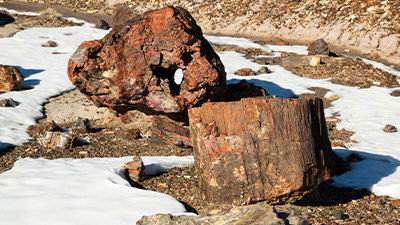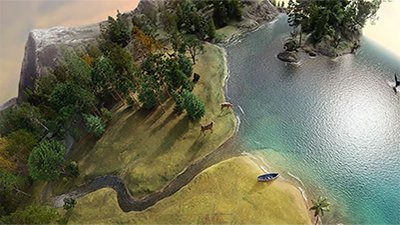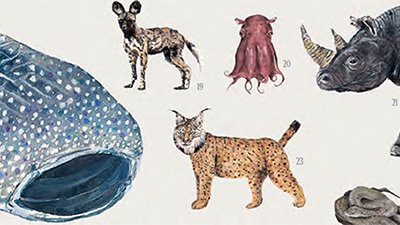Environmental Science
Five Global Warning Claims—Are They True?
Are we causing global warming?. Will many animals and plants go extinct? Global warming has been blamed for increased hurricanes, tornadoes, floods, droughts, and extreme temperatures. While many people support laws to reduce CO2 emissions, believing that this will appreciably slow the progress of global warming, we must consider whether the science supports this claim.
Climate Change Disagreements
The debate over climate change is far from a settled issue even among secular scientists. There is a lot of controversy, not over climate change itself, as everyone agrees climate changes, but over the cause of such changes, specifically whether man has contributed significantly to such changes.
The Ice Age
Simulations confirm that warm oceans after the Genesis Flood caused intense evaporation and snow and ice storms during a single Ice Age of short duration. If we use God’s Word as our starting point, we do not need to rely on unknown mechanisms that require hundreds of thousands of years. The Bible gives us the big picture that helps make sense of our world.
Earth Day Challenge
A proper and balanced perspective on caring for the Earth and its inhabitants comes not from merely promoting “environmental awareness” but is only found within the biblical framework, i.e. recognizing humans were created by a loving God and given the responsibility to rule over, subdue, and care for the rest of the Creation, once “very good,” but now suffering from the curse of sin.
Environmental Science Topics
-
Climate Change
Both the media and popular culture are saturated in the hype of global warming and climate change. How should Christians understand this sensitive issue?
-
Ice Age
How should the Ice Age, glaciers, and wooly mammoths be understood within the framework of the Bible’s history?
-
Stewardship
God has commanded man to be a good steward of the earth that He entrusted to us. In a time of almost cultish concern for the earth, how do Christians respond?
News About Environmental Science
-
July 13, 2023 from Ken Ham Blog
Are humans causing the earth’s temperature to change?
-
Jan. 8, 2021 from Ken Ham Blog
How polar ice sheets developed after the global flood and why ice cores don’t tell us how to address climate change.
-
June 22, 2020 from Ken Ham Blog
Scientists discover Antarctica was once home to a swampy, temperate rainforest likely before catastrophic plate tectonic activity during the global flood.
-
Feb. 13, 2020 from Ken Ham Blog
See how the post-flood ice age and land bridges are being confirmed by secular scientists—something creation apologists have been saying for years.
Articles About Environmental Science
-
Dec. 13, 2025 from Answers Magazine
When a fresh snowfall blankets the world, we retreat indoors to the warm shelter of our homes. But where do wild animals take shelter from the cold?
-
Oct. 1, 2025 from Answers Magazine
When invasive species clash with native ecosystems, biologists face tangled questions about biblical dominion.
-
Jan. 12, 2025 from Answers Magazine
Even snow harbors its own microscopic garden of life that we have only just unearthed within the last decade.
-
Oct. 1, 2024 from Answers Magazine
We can’t deny that humans have left their mark on the earth. But have we ushered in a new geologic epoch?
-
Oct. 1, 2024 from Answers Magazine
Birds are some of the flashiest animals on the planet, with colorful feathers that steal the show. This rainbow variety certainly speaks to the creativity and artistry of our Creator.
-
March 19, 2023 from Answers Magazine
Electric cars are parked at the center of a charged debate. How can you know when and whether to buy in?
-
April 22, 2021 from Answers Magazine
Did the Creator foresee the biological resources we would need to help correct our mistakes, as we fulfill His command to “subdue the earth”?
-
April 1, 2021 from Answers Magazine
As stewards of creation, sometimes we must work with fire, not against it.
-
Oct. 1, 2020 from Answers Magazine
The green movement is dominated by secular environmentalists. But when it comes to creation care, Christians have a deeper calling.
-
Oct. 1, 2020 from Answers Magazine
As modern homesteaders, Erik and Patty Lutz have a firsthand understanding of biblical dominion.
-
Oct. 1, 2020 from Answers Magazine
Plastic pollution has invaded even the most remote places. Should Christians be concerned?
-
Sept. 20, 2020 from Answers Magazine
As God’s creatures disappear, Christians have the opportunity to model the Creator’s spirit of wise conservation.
-
Sept. 13, 2020 from Answers Magazine
Ugly, worthless, annoying—does our opinion of some creatures reflect the Creator’s care or do we need an attitude adjustment?
-
March 1, 2020 from Answers Magazine
Secular scientists struggle to explain what caused the cyclical ice ages that many believe happened in the past.
-
Feb. 26, 2020 from Answers Magazine
In reality, only a small sampling of climate scientists believes we are facing imminent doom. So why all the insistence on anxiety and panic?
-
Jan. 1, 2020 from Answers Magazine
When people reject the Bible, they will misinterpret why the world is changing—including the climate.
-
Dec. 28, 2019 from The New Answers Book 4
Transitional forms in the fossil record are rarely, if ever, observed. This lack of evidence is very damaging to macroevolutionary theory.
-
July 1, 2019 from Answers Magazine
Weather forecasting is a good reminder of the limits of science. It is a useful tool, but it is bound by human finiteness and fallibility.
-
June 5, 2017 from Answers Magazine
Some people believe creation is something we should worship. Others believe its purpose is to serve mankind’s greater good. Which view is right?
-
Dec. 4, 2016 from Answers Magazine
Remnants of a cypress forest were recently discovered off Alabama’s coast. What climate changes could explain such a massive rise in ocean level?
-
Dec. 23, 2015 from Countering the Culture
Geologists claim their work with the fossil Dicynodon shows that the supposed terrestrial mass extinction happened before the marine extinction.
-
Dec. 21, 2015 from Countering the Culture
What can we do to help corals survive and why should we want to?
-
Magazine Department ArticleCloudy with a Chance of AwesomeApril 1, 2015 from Answers Magazine
A thunderstorm is awe inspiring, but an even more awesome display of God’s power is the supercell.
-
Magazine Department ArticleThe Everlasting StormJan. 1, 2014 from Answers Magazine
If lightning never strikes the same place twice, it’s running out of options on the Catatumbo River in Venezuela, South America.
-
Pollution EvolutionFeb. 26, 2011 from News to Know
Another prominently reported example of “evolution” illustrates just the opposite—and supports the creationist critique of Darwinian evolution.
-
Magazine ArticleConservation ClashesMarch 1, 2002, pp. 5–6
Last issue's environment article got the most response. We list the main objections here, followed by comment in brackets.
-
Magazine ArticleTropical Rainforests—a Created Treasure Trove!Dec. 1, 1993, pp. 26–28
Amid the pessimism and gloom over the future of the rainforests of the earth, conservation funds are being obtained from the pharmaceutical industry.
Recommended Resources

Answers in Genesis is an apologetics ministry, dedicated to helping Christians defend their faith and proclaim the good news of Jesus Christ.
- Customer Service 800.778.3390
- Available Monday–Friday | 9 AM–5 PM ET
- © 2026 Answers in Genesis







































